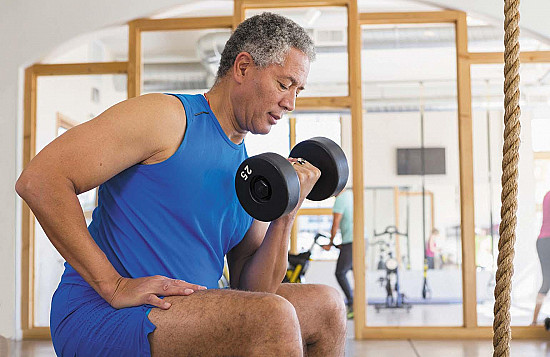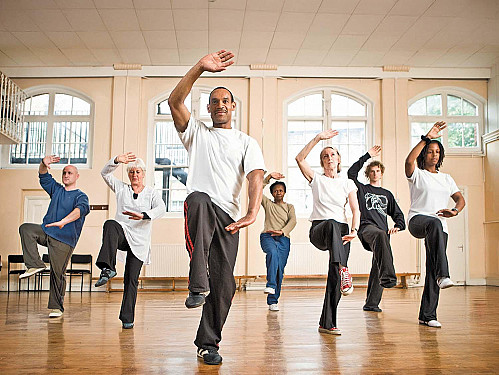7 things your personal trainer wants you to know
Try these insider tips to get the most from your workouts.
- Reviewed by Anthony L. Komaroff, MD, Editor in Chief, Harvard Health Letter; Editorial Advisory Board Member, Harvard Health Publishing
 Working with a personal trainer is a helpful step toward reaching your exercise and fitness goals. Trainers are pros at developing routines for your specific needs, teaching you how to perform exercises properly, and keeping you motivated. Yet it takes more than a weekly session to maximize exercise benefits. Here are seven important strategies personal trainers want you to practice.
Working with a personal trainer is a helpful step toward reaching your exercise and fitness goals. Trainers are pros at developing routines for your specific needs, teaching you how to perform exercises properly, and keeping you motivated. Yet it takes more than a weekly session to maximize exercise benefits. Here are seven important strategies personal trainers want you to practice.
1. Do your homework
If your trainer recommends exercising a certain number of times per week, follow the advice. "My job is augmenting what you do on your own. To make progress, do the routine at least once in a training session and twice on your own, and possibly more depending on your health," says Vijay Daryanani, a certified personal trainer and physical therapist at Harvard-affiliated Spaulding Rehabilitation Hospital.
2. Strength train first
When you strengthen your muscles (with free weights, for example), your body uses stored sugar (glycogen) for energy. Daryanani recommends doing that before starting aerobic exercise that works your heart and lungs (such as brisk walking or a dance workout).
"It takes about 20 minutes to burn through glycogen stored in the muscles," he says. "When that's gone, the best fuel source for your body will be fat, so that's the better time to try to burn fat with an aerobic workout."
Remember to warm up for a few minutes before any type of workout. March in place and move your arms, walk on a treadmill, ride a stationary bike, or use an elliptical machine.
3. Rest your muscles
A strengthening routine makes microscopic tears in the muscle fibers. Resting your muscles for a couple of days gives them time to repair, recover, and grow back stronger. "Ideally, focus on your upper-body muscles one day, and your lower-body muscles the next," Daryanani says. "Or work both muscle groups in one workout, but take a day off before your next exercise session."
Sleeping seven to nine hours per night is also essential to the repair and recovery process, not just for your muscles but for your entire body, especially your brain, blood vessels, and heart.
4. Switch up your routine
Doing the same exercises all the time can cause the muscles to become complacent and stop getting stronger. Daryanani advises that you challenge your muscles with a variety of exercises. "Work the same muscles, but do it a little differently. For example, if you're doing squats, mix in some lunges. Slight changes in positions and angles are enough to make the muscles work harder," he says.
5. Stretch regularly
Stretching keeps your muscles long and supple, which makes them more flexible, protects them from injury, and improves your range of motion. The best time to stretch the muscles is once they're warmed up, either after a quick warm-up or a regular workout. Stretch all of the major muscle groups — including the neck, shoulders, chest, trunk, lower back, hips, legs, and ankles — at least a few times per week. And don't bounce during a stretch; that can injure muscle fibers. "Hold the stretch," Daryanani says. "A 30-second stretch is fine, and a 60-second stretch is even more effective."
6. Eat a healthy diet
Give your body healthy fuels that come from hydration and good food. You need three to six cups of fluids (such as water, juice, or watery foods like soups) each day, and more if you work up a serious sweat during a workout. And eat a plant-based diet that emphasizes fruits, vegetables, nuts, and whole grains; moderate amounts of fish, and poultry; and limited portions of red or processed meats. What if your diet goes off the rails sometimes? "It won't ruin the benefit of exercise, but it sure won't help it," Daryanani says.
7. Exercise with purpose
Exercising takes time and work. Daryanani says it requires purpose, too. "A workout shouldn't be something you just check off your to-do list," he says. "Be thoughtful about it. Ask how you can make your routine more effective and get the most benefits from it. Then, go the extra mile and work out in a way that will move the dial closer to your goals. I can help people do that, but it's up to them to make it happen regularly."
Image: © Kali9/Getty Images
About the Author

Heidi Godman, Executive Editor, Harvard Health Letter
About the Reviewer

Anthony L. Komaroff, MD, Editor in Chief, Harvard Health Letter; Editorial Advisory Board Member, Harvard Health Publishing
Disclaimer:
As a service to our readers, Harvard Health Publishing provides access to our library of archived content. Please note the date of last review or update on all articles.
No content on this site, regardless of date, should ever be used as a substitute for direct medical advice from your doctor or other qualified clinician.
















